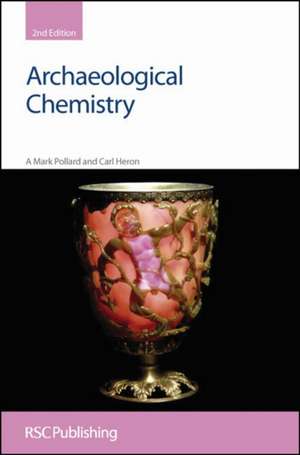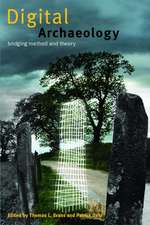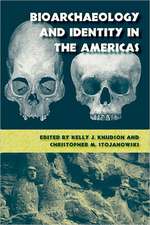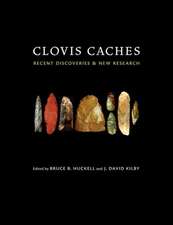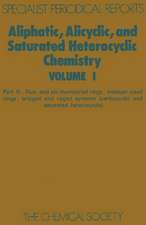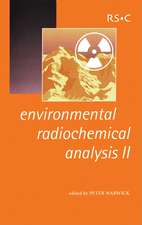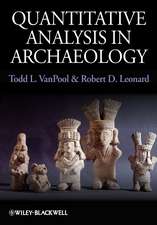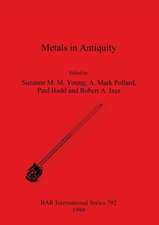Archaeological Chemistry: Rsc: Rsc Paperbacks
Autor A. Mark Pollard, Carl Heron, Royal Society of Chemistryen Limba Engleză Paperback – 31 mar 2008
Din seria Rsc Paperbacks
-
 Preț: 191.22 lei
Preț: 191.22 lei - 8%
 Preț: 397.60 lei
Preț: 397.60 lei -
 Preț: 224.79 lei
Preț: 224.79 lei -
 Preț: 228.77 lei
Preț: 228.77 lei -
 Preț: 256.41 lei
Preț: 256.41 lei -
 Preț: 236.67 lei
Preț: 236.67 lei -
 Preț: 178.59 lei
Preț: 178.59 lei -
 Preț: 272.58 lei
Preț: 272.58 lei -
 Preț: 281.45 lei
Preț: 281.45 lei -
 Preț: 236.46 lei
Preț: 236.46 lei -
 Preț: 194.08 lei
Preț: 194.08 lei -
 Preț: 181.40 lei
Preț: 181.40 lei -
 Preț: 228.39 lei
Preț: 228.39 lei - 14%
 Preț: 1125.13 lei
Preț: 1125.13 lei -
 Preț: 232.80 lei
Preț: 232.80 lei -
 Preț: 237.81 lei
Preț: 237.81 lei -
 Preț: 192.89 lei
Preț: 192.89 lei -
 Preț: 190.38 lei
Preț: 190.38 lei - 5%
 Preț: 244.88 lei
Preț: 244.88 lei -
 Preț: 221.91 lei
Preț: 221.91 lei
Preț: 315.43 lei
Nou
Puncte Express: 473
Preț estimativ în valută:
60.36€ • 63.02$ • 49.95£
60.36€ • 63.02$ • 49.95£
Carte disponibilă
Livrare economică 15-29 martie
Livrare express 01-07 martie pentru 48.36 lei
Preluare comenzi: 021 569.72.76
Specificații
ISBN-13: 9780854042623
ISBN-10: 0854042628
Pagini: 456
Ilustrații: 1
Dimensiuni: 155 x 234 x 30 mm
Greutate: 0.86 kg
Ediția:Nouă
Editura: Royal Society Of Chemistry
Seria Rsc Paperbacks
ISBN-10: 0854042628
Pagini: 456
Ilustrații: 1
Dimensiuni: 155 x 234 x 30 mm
Greutate: 0.86 kg
Ediția:Nouă
Editura: Royal Society Of Chemistry
Seria Rsc Paperbacks
Cuprins
Chapter 1: The Development of Archaeological Chemistry; Chapter 2: Analytical Techniques Applied to Archaeology; Chapter 3: Obsidian Characterization in the Eastern Mediterranean; Chapter 4: The Geochemistry of Clays and the Provenance of Ceramics; Chapter 5: The Chemistry, Corrosion and Provenance of Archaeological Glass; Chapter 6: The Chemical Study of Metals - the Medieval and Later Brass Industry in Europe; Chapter 7: The Chemistry and Use of Resinous Substances; Chapter 8: Amino Acid Stereochemistry and the First Americans; Chapter 9: Lead Isotope Geochemistry and the Trade in Metals; Chapter 10: The Chemistry of Human Bone: Diet, Nutrition, Status and Mobility; Chapter 11: The Detection of Small Biomolecules: Dairy Products in the Archaeological Record; Chapter 12: Summary - Whither Archaeological Chemistry?
Notă biografică
Professor Mark Pollard holds the Edward Hall Professor of Archaeological Science and Director of the Research Laboratory for Archaeology and the History of Art, University of Oxford Professor Mark Pollard's main research interests are the study of archaeological materials , the investigation of biogeochemical processes and numerical applications in archaeology and palaeoclimatic reconstruction. Professor Carl Heron, is Professor of Archaeological Sciences at Bradford University, UK. Professor Carl Heron's main interests Main research interests include molecular archaeology, pottery function and use of history of archaeological science.
Textul de pe ultima copertă
The growth of biomolecular archaeology on all fronts has been dramatic in the twelve years since the first edition was published. The field of archaeology has seen the development of the isotopic study of human bone for the reconstruction of diet, status and mobility. More recently, building on developments in mass spectrometry, a whole new range of organic molecules, including small proteins, has been detected in archaeological contexts. Archaeological Chemistry aims to demonstrate the importance and utility of scientific techniques applied to the study of the past and how the new range of organic molecules has been used to answer questions of major archaeological significance, such as the nature of animal husbandry in the early history of domestication and agriculture. In particular, the role of chemistry is emphasised through a series of case studies, presenting scientific investigation as a challenging field of enquiry rather than a routine application of established procedures. Building on the successful formula of the first edition, this new edition's case studies have been revised, updated and expanded to take account of new perspectives and new data in the intervening decade since the first edition. In addition, two new chapters have been included emphasising the significant increase in molecular and isotopic analysis of organic remains to bring together recent literature about human diets. A special feature of the book is the integration of chemistry and archaeology. At one level, this demonstrates the necessary and relevant role that chemistry plays in the study of the past. At another level, it shows how science and the past combine to enhance our understanding of archaeological materials. The case studies highlight key questions and aim to present the limits of current knowledge but also where research is likely to be focussed in the future. The thematic elements in the book allow the reader to tackle both the science and archaeology of a specific topic in depth. Archaeological Chemistry will prove an essential companion to students in archaeological science and chemistry, field and museum archaeologists and all those involved in conserving human artefacts.
Descriere
Archaeological Chemistry aims to demonstrate the importance and utility of scientific techniques applied to the study of the past.
